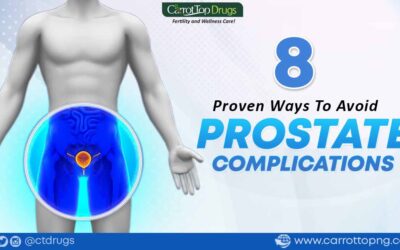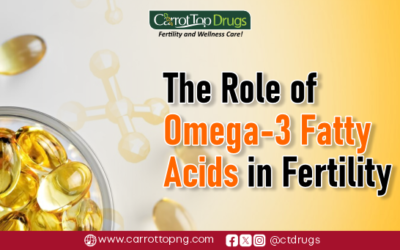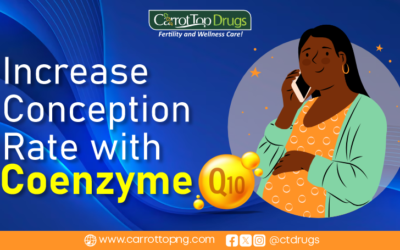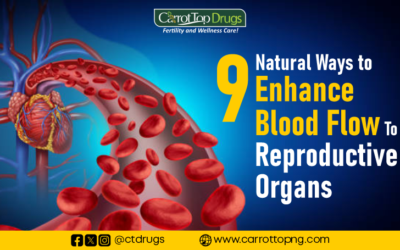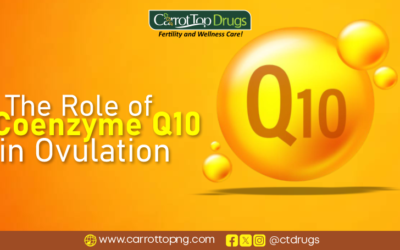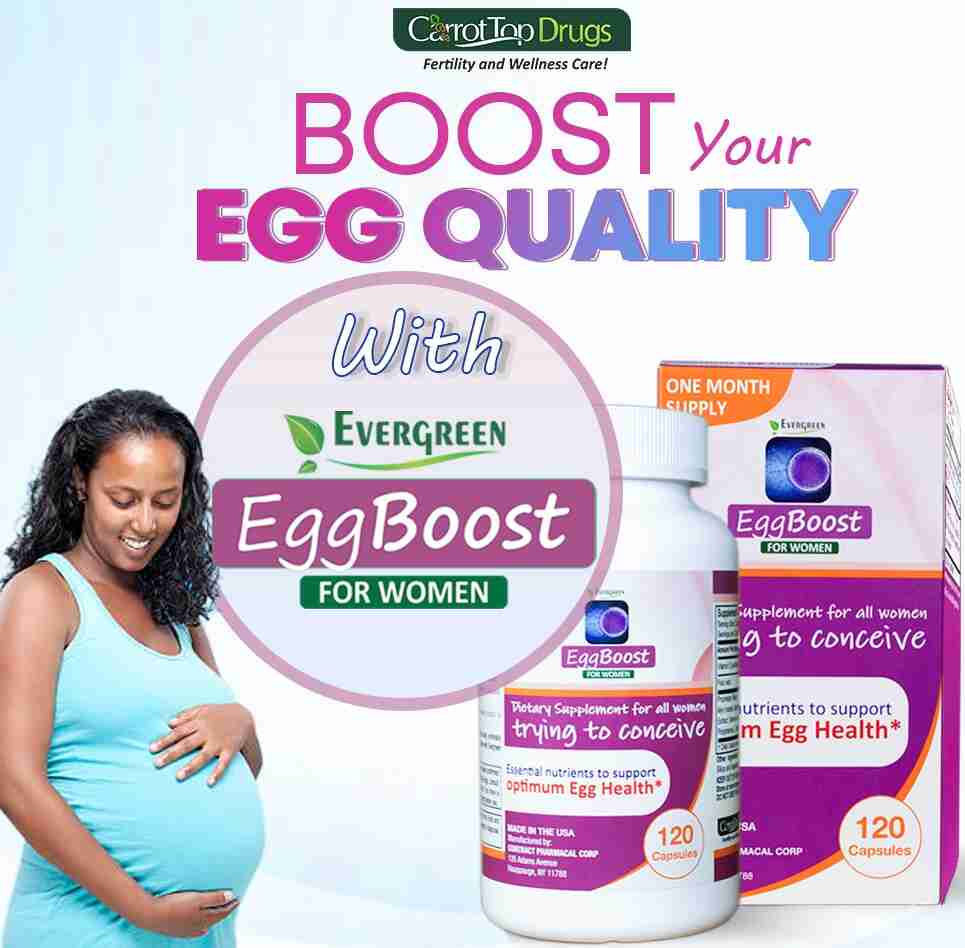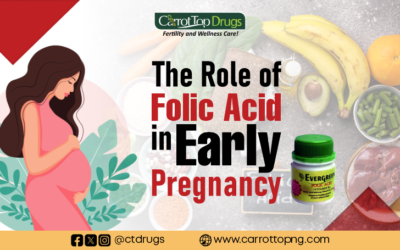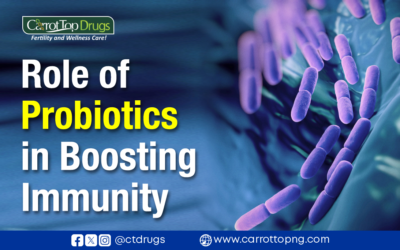What are Reactive Oxygen Species?
Reactive oxygen species (ROS) are chemically active molecules that contain oxygen which the body produces as a byproduct of metabolism. ROS plays a crucial role in many physiological processes, including cellular signalling, immune function, and gene expression. However, high levels of ROS can damage cells and tissues, leading to oxidative stress, inflammation, and disease. In males, it may result in ROS-induced male infertility.
In the male reproductive system, ROS plays a vital role in the development and maturation of sperm cells. However, high levels of ROS can damage sperm and reduce fertility. ROS-induced male infertility is a prevalent condition, affecting many couples globally. In this article, we will examine the causes, effects, and prevention of ROS-induced male infertility.
The Role of ROS in Male Fertility
1. ROS plays a crucial role in the development and maturation of sperm cells.
ROS plays a very important role in the regulation of sperm motility, capacitation, and acrosome reaction.
Reactive oxygen species (ROS) are important for the development and maturation of sperm cells in the male reproductive system. They help regulate several crucial processes, including sperm motility, capacitation, and acrosome reaction.
Sperm motility is essential for fertilization, and ROS plays a role in regulating the movement of sperm cells. Studies have shown that ROS can affect the motility of sperm cells, either positively or negatively. This depends on the concentration and duration of exposure. Low levels of ROS can enhance sperm motility, while high levels can lead to decreased motility and even immobilization.
Capacitation is a process that occurs in the female reproductive tract. The sperm cells undergo biochemical and physiological changes that enable them to fertilize an egg. ROS are involved in the regulation of capacitation. Studies have shown that they play a role in the activation of signalling pathways involved in this process.
The acrosome reaction is a process where the acrosome, a specialized structure in the sperm head, undergoes exocytosis, allowing the sperm cell to penetrate the egg’s outer layer. ROS plays a role in the regulation of the acrosomal reaction. Studies have shown that they play a role in the activation of signalling pathways involved in this process.
However, excessive ROS levels can lead to oxidative stress, which can damage sperm DNA and impair male fertility. Oxidative stress can lead to reduced sperm count, motility, and morphology, as well as increased sperm DNA fragmentation. Additionally, oxidative stress can contribute to other reproductive health issues, such as erectile dysfunction and low libido.
2. ROS also act as signalling molecules, initiating the physiological changes required for fertilization.
In addition to their regulatory roles in sperm motility, capacitation, and acrosome reaction, ROS also act as signalling molecules. They play a crucial role in initiating the physiological changes required for fertilization.
Studies revealed that ROS takes part in the activation of signalling pathways that are critical for the fusion of sperm and egg. ROS help initiate the acrosome reaction, which is essential for sperm to penetrate the egg’s outer layer. Additionally, ROS also play a role in the regulation of calcium signalling. This is necessary for the activation of the egg.
However, excessive ROS levels can lead to oxidative stress, which can damage sperm cells and impair male fertility. ROS can cause lipid peroxidation, DNA damage, and protein oxidation, all of which can affect sperm count, motility, and morphology. Moreover, ROS-induced oxidative stress can contribute to other reproductive health issues, such as erectile dysfunction and low libido.
Several factors can contribute to increased ROS levels in the body. They include exposure to environmental toxins, unhealthy lifestyle habits, and underlying medical conditions. Therefore, it is essential to identify and address these factors to reduce the risk of ROS-induced male infertility.
Causes of ROS-induced male infertility
Several factors can increase ROS levels in the male reproductive system, leading to ROS-induced male infertility. These include:
Environmental Factors
Environmental factors can also contribute to ROS-induced male infertility. Exposure to environmental toxins, such as pesticides, heavy metals, and air pollution, can increase ROS levels in the male reproductive system. These toxins can damage sperm cells and lead to reduced fertility.
Studies have shown that men who work in industries with high exposure to pesticides and other toxins have a higher risk of infertility. Exposure to heavy metals, such as lead, cadmium, and mercury, can also impair male fertility by increasing ROS levels and oxidative stress.
Air pollution is another environmental factor that can contribute to ROS-induced male infertility. Particulate matter in the air can increase ROS levels in the body and impair sperm count, motility, and morphology. Exposure to air pollution has been linked to decreased fertility in both men and women.
Reducing exposure to environmental toxins and pollutants can help reduce the risk of ROS-induced male infertility. Avoiding exposure to pesticides and heavy metals, using protective equipment in the workplace, and living in areas with low levels of air pollution are some of the means to avoid this risk. In addition, adopting healthy lifestyle habits, such as maintaining a balanced diet, quitting smoking, and reducing alcohol consumption, can also help reduce the risk of ROS-induced male infertility.
Lifestyle Factors
Lifestyle factors can also contribute to ROS-induced male infertility. Unhealthy lifestyle habits, such as smoking, alcohol consumption, and drug abuse, can increase ROS levels in the body. Smoking, in particular, increases ROS levels in the seminal fluid and impairs sperm function. Heavy alcohol consumption and drug abuse can also lead to oxidative stress and damage sperm DNA.
In addition to these factors, obesity, and a sedentary lifestyle can also contribute to ROS-induced male infertility. There is a link between obesity and increased ROS levels and decreased sperm count and motility. Regular exercise helps to decrease oxidative stress and improve sperm quality, making it an essential factor for maintaining male fertility.
Moreover, dietary habits can also play a role in ROS-induced male infertility. A diet high in processed and fried foods can increase oxidative stress in the body and damage sperm DNA. Conversely, a diet rich in antioxidants, such as fruits, vegetables, and nuts. They can help reduce oxidative stress and improve sperm quality.
Preventing ROS-induced male infertility requires making lifestyle changes to reduce exposure to environmental toxins, quitting unhealthy habits such as smoking and drug abuse, maintaining a healthy weight, exercising regularly, and following a balanced diet rich in antioxidants.
Medical Conditions
Varicocele is a medical condition characterized by the enlargement of veins in the scrotum, which can lead to increased ROS levels in the testes. This can cause damage to sperm cells and reduce fertility. Infections and inflammation in the male reproductive system can also lead to increased ROS levels and oxidative stress. It can impair sperm function and decrease fertility.
Moreover, medical treatments such as chemotherapy and radiation therapy can increase ROS levels in the body and lead to ROS-induced male infertility. These treatments may cause oxidative stress, which can damage sperm cells and reduce fertility.
It is essential to note that ROS-induced male infertility is a prevalent condition affecting many couples worldwide. Therefore, it is crucial to identify the causes of ROS-induced male infertility and take preventive measures to reduce its impact on male fertility. Lifestyle modifications, such as avoiding smoking, reducing alcohol consumption, and maintaining a healthy diet and exercise routine. They can help reduce ROS levels in the body and improve male fertility. In addition, antioxidant supplements and medical treatments targeting oxidative stress may also be helpful in preventing ROS-induced male infertility.
Age
As men age, their reproductive system undergoes changes that can lead to ROS-induced male infertility. Age-related decline in the production of antioxidants, such as superoxide dismutase (SOD) and catalase, can result in an imbalance between ROS and antioxidant levels, leading to oxidative stress and damage to sperm cells.
Furthermore, ageing can also lead to changes in sperm morphology and motility, which can further exacerbate the effects of ROS on male fertility. These changes can be due to a decline in the number and quality of sperm-producing cells in the testes.
Studies have shown that men over 35 years of age are at a higher risk of experiencing ROS-induced male infertility than younger men. Therefore, it is crucial for men of all ages to maintain a healthy lifestyle and limit exposure to environmental toxins to reduce the risk of ROS-induced male infertility.
Effects of ROS-induced male infertility
ROS-induced male infertility can have several effects on a couple’s ability to conceive. These effects include:
1. Reduced sperm count
High levels of ROS can damage sperm cells, leading to a reduced sperm count. A low sperm count can reduce a couple’s chances of conceiving.
ROS-induced male infertility can also lead to reduced sperm quality and morphology, making it difficult for the sperm to fertilize the egg. Additionally, ROS can cause DNA damage in sperm cells, leading to genetic abnormalities that can result in infertility or birth defects in offspring.
Prevention of ROS-induced male infertility involves reducing exposure to environmental toxins, adopting a healthy lifestyle, and treating any underlying medical conditions. Antioxidants, such as vitamins C and E, can also help reduce ROS levels and improve sperm quality.
2. Reduced sperm motility
ROS-induced damage to sperm cells can also reduce sperm motility, making it more challenging for sperm to reach the egg.
Reduced sperm motility is another significant effect of ROS-induced male infertility. ROS can cause damage to the structures within sperm cells that are responsible for their movement, such as the flagellum, which impairs their ability to swim effectively. This reduced motility makes it more challenging for sperm to navigate through the female reproductive tract and reach the egg for fertilization.
The compromise of sperm motility drastically reduces the chances of conception. Even if the sperm count is normal, if the motility is impaired due to ROS-induced damage, the sperm may struggle to reach the egg in a timely manner. This can greatly impact a couple’s ability to conceive.
ROS-induced damage to the cell membrane of sperm cells can disrupt their normal function and hinder their ability to move efficiently. Additionally, ROS can interfere with the energy production processes within the sperm, further contributing to reduced motility.
It is important to address ROS-induced male infertility and take measures to reduce oxidative stress in order to improve sperm motility. Lifestyle changes, such as adopting a healthy diet rich in antioxidants and engaging in regular physical exercise are some of the means of improving it. Additionally, avoiding exposure to environmental toxins and managing any underlying medical conditions can also help reduce ROS levels and promote better sperm motility.
3. Altered sperm morphology
High levels of ROS can also alter sperm morphology, leading to abnormalities in sperm shape and size.
Altered sperm morphology is another consequence of ROS-induced male infertility. ROS can cause structural damage to the sperm cells, resulting in abnormalities in their shape and size. These abnormalities, known as sperm morphology defects, can significantly impact fertility.
Normal sperm morphology is crucial for successful fertilization as it allows the sperm to effectively penetrate the protective layers surrounding the egg. When sperm morphology is compromised due to ROS-induced damage, the chances of fertilization are reduced. Sperm with abnormal morphology may have difficulty attaching to the egg or penetrating its outer layer, making it more challenging to achieve fertilization.
ROS-induced damage can affect various parts of the sperm, including the head, midpiece, and tail, leading to abnormal morphology. This can include head defects, such as a large or small head, tapered head, or double head; midpiece abnormalities, such as swollen or coiled midpiece; and tail defects, such as a short, bent, or coiled tail. These abnormalities can impair the sperm’s ability to reach and fertilize the egg.
Addressing ROS-induced male infertility and minimizing oxidative stress can help improve sperm morphology. Antioxidant-rich diets, lifestyle modifications, and the use of antioxidant supplements may help reduce the damaging effects of ROS and promote healthier sperm morphology.
4. DNA damage
When sperm cells with damaged DNA fertilize an egg, it can result in genetic abnormalities in the offspring. The damaged DNA can lead to miscarriages, failed implantations, or the birth of a child with developmental or chromosomal abnormalities, such as Down syndrome or structural birth defects.
The integrity of sperm DNA is crucial for the successful development of a healthy embryo. If the DNA is damaged, it can affect the genetic information that is passed on to the next generation. Therefore, reducing DNA damage in sperm cells is essential for maintaining fertility and ensuring the health of future offspring.
Preventing ROS-induced male infertility and reducing DNA damage in sperm cells can be achieved through various strategies. Antioxidant therapy, such as supplementation with vitamins C and E, can help neutralize ROS and protect sperm DNA from oxidative damage. Additionally, lifestyle modifications, such as quitting smoking, reducing alcohol consumption, and avoiding exposure to environmental toxins, can reduce oxidative stress and minimize DNA damage in sperm cells.
It is crucial for couples struggling with ROS-induced male infertility to seek medical advice and undergo fertility evaluations. Specialized treatments, such as assisted reproductive technologies (ART) like intracytoplasmic sperm injection (ICSI), can be utilized to bypass the effects of ROS-induced male infertility and increase the chances of successful fertilization.
5. Increased risk of oxidative stress-related diseases
Men with ROS-induced male infertility may face an increased risk of developing oxidative stress-related diseases. When ROS levels are elevated and the body’s antioxidant defense mechanisms are overwhelmed, oxidative stress can occur. This imbalance can lead to chronic inflammation and damage to cells and tissues, increasing the risk of various diseases.
One such disease is cardiovascular disease. Oxidative stress can contribute to the development of atherosclerosis, a condition characterized by the buildup of plaque in the arteries. The oxidative damage caused by ROS can promote inflammation and damage the inner lining of blood vessels, leading to the formation of plaques that can restrict blood flow and increase the risk of heart attacks and strokes.
Furthermore, oxidative stress is also associated with an increased risk of diabetes. ROS can impair insulin signaling and disrupt glucose metabolism, leading to insulin resistance and the development of type 2 diabetes. The chronic inflammation caused by oxidative stress can further exacerbate the progression of diabetes and its associated complications.
Cancer is another disease that can be influenced by ROS-induced male infertility. High levels of ROS can damage DNA and promote genetic mutations, which can contribute to the development of cancer cells. ROS-induced DNA damage can disrupt normal cellular processes, leading to uncontrolled cell growth and the formation of tumors.
It is important for men experiencing ROS-induced male infertility to be aware of the potential health risks associated with oxidative stress. Taking steps to reduce oxidative stress through lifestyle modifications, such as adopting a healthy diet, engaging in regular exercise, and managing stress levels, can help mitigate the risk of oxidative stress-related diseases.
Diagnosis of ROS-induced male infertility
Diagnosing ROS-induced male infertility involves several tests and examinations, including:
1. Semen analysis
A semen analysis is a crucial diagnostic tool used to evaluate the quality and quantity of sperm in a man’s semen. It provides valuable insights into the reproductive health of an individual and can help identify potential causes of male infertility, including ROS-induced factors.
During a semen analysis, several parameters are assessed. These include sperm count, which measures the number of sperm present in a given sample; sperm motility, which evaluates the percentage of sperm that are moving and their ability to swim in a coordinated manner; and sperm morphology, which examines the size, shape, and structure of sperm cells.
ROS-induced male infertility can significantly affect these parameters. High levels of ROS can lead to reduced sperm count, impaired motility, and abnormal morphology. By conducting a semen analysis, healthcare professionals can identify these abnormalities and determine the extent of ROS-induced damage to sperm cells.
A low sperm count, decreased motility, and abnormal morphology can indicate the presence of oxidative stress and highlight the need for further investigation and treatment. In such cases, additional tests may be recommended to assess the level of ROS in the semen or to evaluate the extent of DNA damage in sperm cells.
Based on the results of the semen analysis, healthcare providers can develop personalized treatment plans to address ROS-induced male infertility. These may include lifestyle modifications to reduce oxidative stress, antioxidant supplementation to enhance sperm quality, or assisted reproductive techniques to bypass the effects of ROS and increase the chances of successful fertilization.
Regular monitoring through follow-up semen analyses can help track improvements in sperm parameters and assess the effectiveness of treatment interventions. It is important for individuals experiencing ROS-induced male infertility to undergo semen analyses as part of the diagnostic process and to guide appropriate management strategies.
2. Sperm DNA fragmentation test
The sperm DNA fragmentation test is a diagnostic tool used to assess the integrity of DNA within sperm cells. It provides valuable information about the extent of DNA damage and can help identify potential causes of male infertility, including ROS-induced factors.
DNA fragmentation refers to the breakage or alteration of DNA strands within sperm cells. High levels of ROS can lead to oxidative stress, which can cause damage to the DNA molecule. The sperm DNA fragmentation test measures the percentage of sperm cells with fragmented DNA, indicating the presence of DNA damage.
The test involves collecting a semen sample and subjecting it to laboratory analysis. There are several techniques to assess DNA fragmentation, including the terminal deoxynucleotidyl transferase dUTP nick end labeling (TUNEL) assay, the sperm chromatin structure assay (SCSA), or the comet assay. These methods can provide quantitative and qualitative information about DNA integrity.
In the context of ROS-induced male infertility, the sperm DNA fragmentation test is particularly relevant. High levels of ROS can directly impact the stability of DNA within sperm cells, leading to increased fragmentation. Increased DNA fragmentation is associated with reduced fertility potential and an increased risk of failed fertilization, implantation failure, and miscarriage.
By measuring DNA fragmentation, healthcare professionals can gain insights into the extent of DNA damage caused by oxidative stress. This information can guide treatment decisions and help develop targeted interventions to improve fertility outcomes. Strategies to reduce DNA damage may include antioxidant therapy, lifestyle modifications, and the use of assisted reproductive techniques such as intracytoplasmic sperm injection (ICSI).
3. ROS Measurement
ROS measurement is an important diagnostic approach used to assess the levels of reactive oxygen species (ROS) in semen. It provides valuable information about the oxidative stress status in the male reproductive system and can help identify the presence of ROS-induced male infertility.
High levels of ROS can have detrimental effects on sperm cells, leading to oxidative stress and impairing sperm quality and function. Measuring ROS levels in the semen can help identify the extent of oxidative damage and guide appropriate treatment strategies.
There are various techniques available to measure ROS in semen. One commonly used method is the chemiluminescence assay, which measures the production of light resulting from the reaction of ROS with a luminol probe. Another method is electron paramagnetic resonance (EPR) spectroscopy, which detects and quantifies ROS by measuring their unpaired electrons.
By measuring ROS levels, healthcare professionals can assess the oxidative stress burden on sperm cells. Elevated ROS levels may indicate increased oxidative damage, which can affect sperm count, motility, morphology, and DNA integrity. These factors can significantly impact male fertility and increase the risk of ROS-induced male infertility.
Based on the results of ROS measurement, healthcare providers can develop personalized treatment plans to address ROS-induced male infertility. These may include lifestyle modifications to reduce oxidative stress, antioxidant therapy to counteract the effects of ROS, or other targeted interventions to improve sperm quality and function.
Regular monitoring of ROS levels in the semen can also help track the effectiveness of treatment interventions and provide insights into the progression of oxidative stress. Adjustments to treatment plans can be made based on the changes observed in ROS levels over time.
Treatment options for ROS-induced male infertility
Several treatment options are available for ROS-induced male infertility, including:
1. Antioxidant therapy
Antioxidant therapy is a potential treatment approach for ROS-induced male infertility. Antioxidants are molecules that have the ability to neutralize reactive oxygen species (ROS) and protect cells from oxidative damage. By reducing ROS levels, antioxidant therapy aims to mitigate the detrimental effects of oxidative stress on sperm cells and improve fertility outcomes.
Several antioxidants have been studied for their potential benefits in male infertility. These include vitamin C (ascorbic acid), vitamin E (tocopherol), coenzyme Q10 (ubiquinone), selenium, zinc, and lycopene, among others. These antioxidants work by scavenging ROS, preventing their harmful interactions with cellular components and reducing oxidative damage.
Vitamin C and Vitamin E
Vitamin C is a water-soluble antioxidant that can penetrate cells and neutralize ROS. It plays a crucial role in protecting sperm cells from oxidative stress and improving sperm quality. Vitamin E, on the other hand, is a fat-soluble antioxidant that can protect cell membranes from lipid peroxidation caused by ROS. It helps maintain the integrity of sperm cells and supports their proper function.
Coenzyme Q10
Coenzyme Q10 is an antioxidant that plays a key role in cellular energy production. It not only scavenges ROS but also helps regenerate other antioxidants, such as vitamin E. Coenzyme Q10 supplementation has shown promise in improving sperm count, motility, and morphology in men with ROS-induced male infertility.
Selenium and Zinc
Selenium and zinc are essential trace minerals that act as cofactors for antioxidant enzymes in the body. They play critical roles in protecting against oxidative damage and maintaining sperm health. Lycopene, a carotenoid pigment found in tomatoes and other fruits, has also been studied for its antioxidant properties and potential benefits in male fertility.
Antioxidant therapy can be administered through dietary modifications and the use of antioxidant supplements like EVERGREEN FORMULAR FOR MEN. The supplementation dosage and duration may vary depending on individual needs and underlying causes of infertility. It is important to consult with a healthcare professional before starting any antioxidant therapy to ensure appropriate dosing and monitoring.
While antioxidant therapy holds promise in mitigating the effects of ROS-induced male infertility, it is important to note that its effectiveness may vary among individuals.
2. Medications
Medications can be prescribed as part of the treatment plan for ROS-induced male infertility. Clomiphene citrate and tamoxifen are two medications that have shown the potential in improving sperm count and motility in men affected by this condition.
Clomiphene citrate is a medication for stimulating ovulation in women, but it can also be beneficial for men with infertility issues. It works by increasing the production of follicle-stimulating hormone (FSH) and luteinizing hormone (LH) in the body, which in turn stimulates the testes to produce more testosterone and enhance sperm production. By boosting testosterone levels and supporting spermatogenesis, clomiphene citrate can help improve sperm count in men with ROS-induced male infertility.
Tamoxifen, primarily known as a medication used in the treatment of breast cancer, has also shown promise in enhancing male fertility. It acts as a selective estrogen receptor modulator (SERM), blocking the effects of estrogen in the hypothalamus and pituitary gland. This leads to increased production of FSH and LH, which can stimulate the testes to produce more testosterone and improve sperm production. Tamoxifen increases sperm count and motility in men with ROS-induced male infertility.
It is important to note that the use of these medications should be under the guidance of a healthcare professional. They will assess the individual’s specific condition, perform necessary evaluations, and determine the most appropriate treatment approach. The dosage and duration of medication use will be personalized based on the patient’s needs and response to treatment.
3. Surgical interventions
Surgical interventions can be considered for the treatment of ROS-induced male infertility, particularly in cases where the underlying cause is a specific anatomical issue. One such surgical procedure is varicocelectomy, which is performed to address varicocele-induced male infertility.
Varicocele is a condition characterized by the enlargement of veins within the scrotum, leading to increased blood flow and elevated temperature in the testicles. This can result in oxidative stress and the production of high levels of ROS, which can negatively impact sperm quality and fertility. Varicocelectomy involves the surgical ligation or removal of the affected veins, reducing the pooling of blood and restoring normal blood flow to the testicles.
By correcting the varicocele, varicocelectomy aims to reduce ROS levels and improve sperm parameters, including count, motility, and morphology. This procedure has been shown to be effective in improving fertility outcomes for men with varicocele-induced ROS-induced male infertility.
It is important to note that surgical interventions should be carefully considered and discussed with a healthcare professional. Not all cases of ROS-induced male infertility are suitable for surgical intervention, and the decision to undergo surgery should be based on a thorough evaluation of the individual’s specific condition and needs.
While varicocelectomy has shown promise in improving fertility, it is not a guaranteed solution for all cases of ROS-induced male infertility. Factors such as the severity of the varicocele, overall sperm health, and other underlying causes of infertility should be taken into account when determining the most appropriate treatment approach.
Prevention of ROS-induced Male Infertility
Several lifestyle and nutritional interventions can help prevent ROS-induced male infertility, including:
1. Lifestyle changes to reduce ROS levels
Making certain lifestyle changes can significantly contribute to reducing ROS levels in the body and mitigate the risk of ROS-induced male infertility. Implementing these changes can positively impact overall health and fertility. Here are some lifestyle modifications to consider:
Quit smoking:
Smoking is known to increase ROS production and oxidative stress in the body. By quitting smoking, individuals can lower their ROS levels and improve overall reproductive health. Smoking cessation also brings about numerous other health benefits.
Reduce alcohol consumption:
Excessive alcohol consumption has been linked to increased ROS levels and oxidative stress. Cutting back on alcohol or eliminating it altogether can help maintain a healthy balance of ROS in the body and promote better fertility.
Avoid exposure to environmental toxins:
Pesticides, heavy metals, air pollution, and other environmental toxins can elevate ROS levels and harm sperm cells. Taking measures to minimize exposure to these toxins, such as using protective gear, choosing organic products, and living in clean environments, can be beneficial.
Eat a balanced diet rich in antioxidants:
Antioxidants play a crucial role in neutralizing ROS and protecting cells from oxidative damage. Including antioxidant-rich foods in the diet, such as fruits, vegetables, nuts, and seeds, can help reduce ROS-induced male infertility by supporting a healthier oxidative balance.
Manage stress levels:
Chronic stress can contribute to increased ROS production in the body. Implementing stress-management techniques like regular exercise, meditation, and relaxation practices can help lower stress levels and reduce oxidative stress.
Maintain a healthy weight:
Obesity is associated with higher levels of oxidative stress. Engaging in regular physical activity and maintaining a healthy weight can help reduce ROS levels and promote better fertility.
Get regular exercise:
Physical activity reduces oxidative stress and improves overall health. Engaging in regular exercises, such as aerobic activities, strength training, or sports, can help lower ROS levels and enhance fertility.
2. Nutritional interventions to reduce ROS levels
Nutritional interventions play a significant role in reducing ROS levels in the body and addressing ROS-induced male infertility. Consuming a healthy, balanced diet that is abundant in antioxidants can help combat oxidative stress and promote better reproductive health. Here are some key nutritional strategies to consider:
Antioxidant-rich foods:
Incorporate foods that are naturally rich in antioxidants into your daily diet. Fruits like berries (such as blueberries, strawberries, and raspberries), citrus fruits, and pomegranates are excellent sources of antioxidants. Vegetables such as leafy greens (spinach, kale, and broccoli), bell peppers, and tomatoes also provide valuable antioxidants. Additionally, include whole grains, nuts, and seeds that offer antioxidant properties.
Vitamins and minerals:
Ensure adequate intake of vitamins and minerals known to have antioxidant properties. Vitamin C, vitamin E, beta-carotene (a precursor to vitamin A), and selenium are particularly important. Citrus fruits, kiwis, almonds, spinach, and sweet potatoes are good sources of these nutrients.
Omega-3 fatty acids:
Include foods rich in omega-3 fatty acids in your diet. Fatty fish (such as salmon, mackerel, and sardines), flaxseeds, chia seeds, and walnuts are excellent sources of omega-3 fatty acids. Research reveals that these fatty acids have antioxidant and anti-inflammatory effects, which can help reduce oxidative stress.
Limit processed foods and refined sugars:
Highly processed foods and those containing refined sugars may contribute to increased oxidative stress. Opt for whole, unprocessed foods and limit your consumption of sugary snacks, desserts, and sugary beverages.
Hydration:
Stay adequately hydrated by drinking plenty of water throughout the day. Water helps in maintaining overall cellular health and supports the body’s detoxification processes.
Herbal supplements:
Some herbal supplements, such as green tea extract and resveratrol (found in grapes and red wine), have antioxidant properties. However, it’s important to consult with a healthcare professional before incorporating any herbal supplements into your routine, as they may interact with medications or have potential side effects.
3. Antioxidant supplementation for ROS-induced male infertility
Supplementation with antioxidants such as vitamin C, vitamin E, and coenzyme Q10 can help reduce ROS levels in the body, reducing the risk of ROS-induced male infertility.
Antioxidant supplementation is a potential approach to address ROS-induced male infertility. Antioxidants, such as vitamin C, vitamin E, and coenzyme Q10, neutralize ROS and reduce oxidative stress in the body. Here’s an overview of the key antioxidants and their potential benefits:
Vitamin C: This water-soluble vitamin is a potent antioxidant that can scavenge free radicals and protect against oxidative damage. It helps regenerate vitamin E, another important antioxidant. Studies have suggested that vitamin C supplementation may improve sperm quality, including sperm count, motility, and morphology, in men with ROS-induced male infertility.
Vitamin E: As a fat-soluble vitamin, vitamin E protects cell membranes from oxidative damage. It can enhance sperm motility and protect sperm DNA integrity. Some research suggests that vitamin E supplementation may improve semen parameters in men with ROS-induced male infertility.
Coenzyme Q10: Coenzyme Q10 (CoQ10) is a naturally occurring compound involved in cellular energy production. It also acts as an antioxidant, protecting cells from oxidative stress. CoQ10 supplementation has shown the potential in improving sperm quality, including sperm count, motility, and morphology, in men with ROS-induced male infertility.
While antioxidant supplementation shows promise, it’s essential to consult with a healthcare professional before starting any supplementation regimen. EVERGREEN FORMULAR FOR MEN is a nutritional supplement that comprises most of all these nutrients. It prevents the impact of ROS on the semen or sperm quality of the man.
The Importance of Maintaining Optimal ROS Levels in Male Fertility
High levels of ROS can lead to oxidative stress, a condition where there is an imbalance between the production of ROS and the body’s antioxidant defense mechanisms. This oxidative stress can damage sperm cells, including their DNA, leading to reduced fertility and an increased risk of infertility issues.
ROS-induced male infertility is a significant concern globally, affecting many couples who are trying to conceive. By understanding the importance of maintaining optimal ROS levels, individuals can take proactive steps to protect their reproductive health.
Lifestyle interventions play a critical role in managing ROS-induced male infertility. Avoiding or minimizing exposure to environmental toxins, such as pesticides, heavy metals, and air pollution, can help reduce ROS levels in the male reproductive system. Addressing unhealthy lifestyle habits, such as smoking, alcohol consumption, and drug abuse is necessary as they can increase ROS levels and impair fertility.
Nutritional interventions are also essential in managing ROS-induced male infertility. A well-balanced diet that includes antioxidant-rich foods, such as fruits, vegetables, and whole grains, provides the body with essential nutrients and antioxidants to combat oxidative stress. These antioxidants help neutralize ROS and protect sperm cells from damage.
In addition to lifestyle and nutritional interventions, antioxidant supplementation is a supportive measure. Antioxidant supplements like vitamin C, vitamin E, and coenzyme Q10 have shown promise in reducing ROS levels and improving sperm quality in men with ROS-induced male infertility.
Regular monitoring of ROS levels through tests like semen analysis and sperm DNA fragmentation tests can provide valuable insights into the impact of ROS on male fertility. These tests help identify abnormalities in sperm count, motility, morphology, and DNA integrity, which can be indicative of ROS-induced male infertility.
FAQs
Q. Can ROS-induced male infertility be cured?
A. You can manage ROS-induced male infertility by using a combination of lifestyle changes, nutritional interventions, and medical treatments.
Q. Can exposure to environmental toxins cause ROS-induced male infertility?
A. Yes, exposure to environmental toxins such as pesticides, heavy metals, and air pollution can increase ROS levels in the body, leading to ROS-induced male infertility.
Q. Can age contribute to ROS-induced male infertility?
A. Yes, as men age, the body’s ability to produce antioxidants declines, leading to increased ROS levels and reduced fertility.
Q. Can a healthy diet reduce the risk of ROS-induced male infertility?
A. Yes, a healthy, balanced diet rich in antioxidants can help reduce ROS levels in the body,
Q. Can smoking cause ROS-induced male infertility?
A. Yes, smoking is a significant source of ROS in the body and can lead to increased oxidative stress and reduced fertility.
Q. Can stress contribute to ROS-induced male infertility?
A. Yes, stress can lead to increased ROS levels in the body, leading to oxidative stress and reduced fertility.
Q. What role do antioxidants play in male fertility?
A. Antioxidants play a crucial role in male fertility by neutralizing ROS and reducing oxidative stress in the body. They can help improve sperm count, motility, and morphology, leading to improved fertility.
Q. Can varicocele be a cause of ROS-induced male infertility?
A. Yes, varicocele is a common cause of ROS-induced male infertility. Varicocele is a condition in which the veins in the scrotum become enlarged and can lead to increased ROS levels and reduced fertility.
Q. Is ROS-induced male infertility a reversible condition?
A. In many cases, ROS-induced male infertility can be managed and treated using a combination of lifestyle changes, nutritional interventions, and medical treatments. However, the extent of reversibility depends on the severity of the condition and the underlying causes.
Conclusion
Overall, it is essential to maintain optimal ROS levels in the body to ensure healthy reproductive function. By adopting healthy lifestyle habits, such as quitting smoking, reducing alcohol consumption, and maintaining a balanced diet, men can reduce their risk of ROS-induced male infertility and improve their overall reproductive health. Additionally, medical treatments such as antioxidant therapy, medication, and surgical interventions can help manage and treat ROS-induced male infertility.


